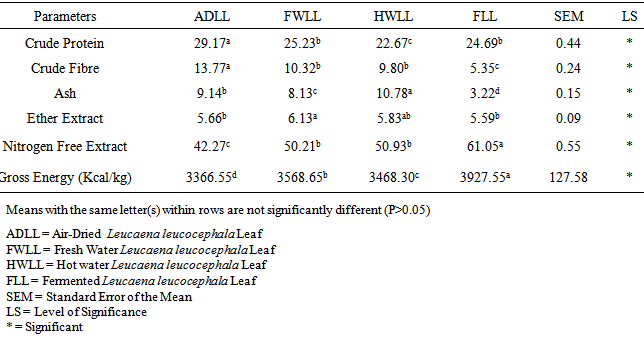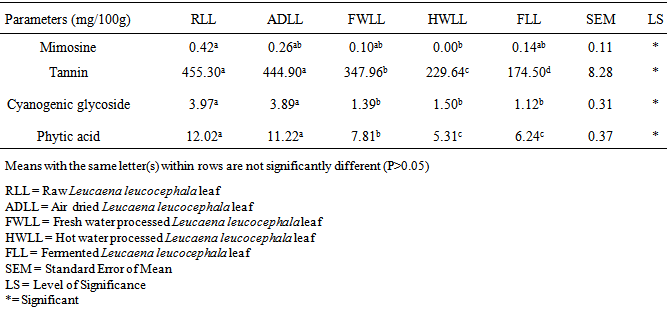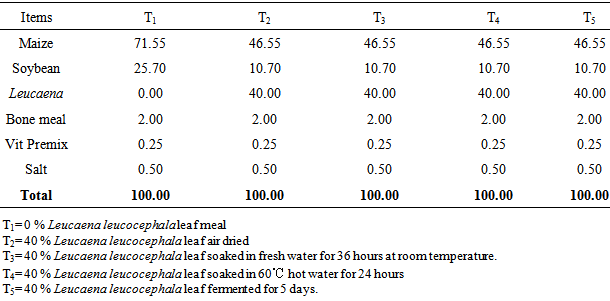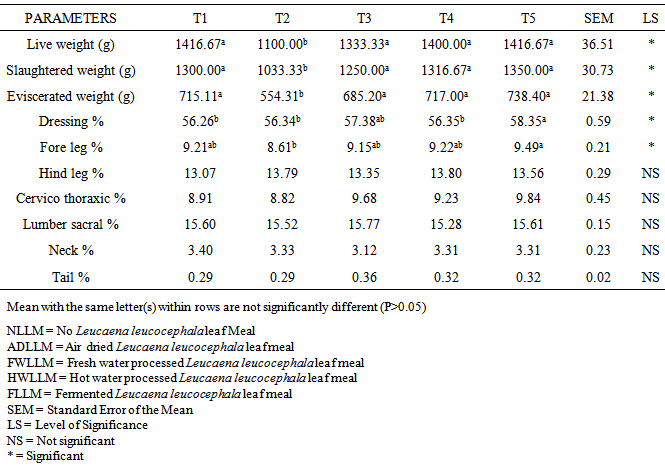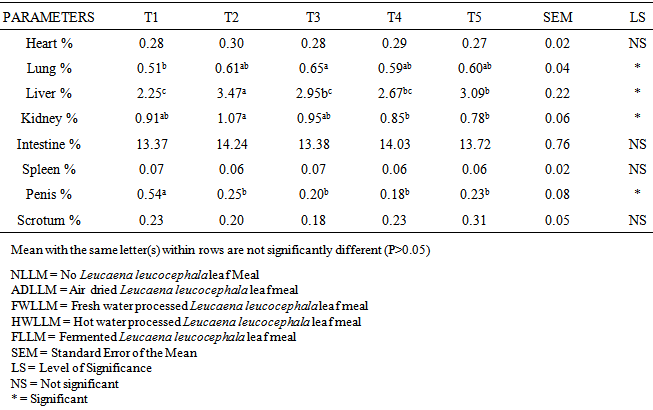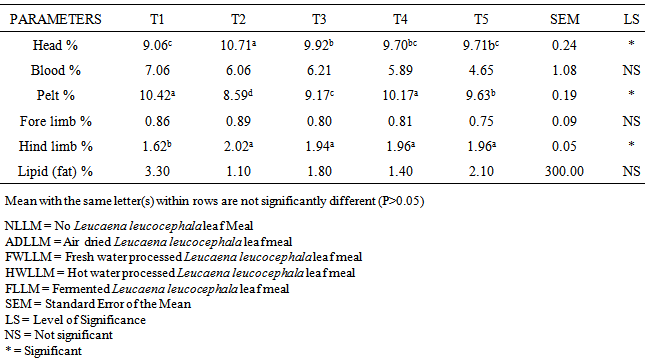-
Paper Information
- Next Paper
- Paper Submission
-
Journal Information
- About This Journal
- Editorial Board
- Current Issue
- Archive
- Author Guidelines
- Contact Us
International Journal of Food Science and Nutrition Engineering
p-ISSN: 2166-5168 e-ISSN: 2166-5192
2014; 4(5): 118-127
doi:10.5923/j.food.20140405.02
Effects of Dietary Inclusion of Differently Processed Leucaena leucocephala Leaf Meal on Carcass Characteristics of Rabbits (Oryctolagus cunniculus)
Adekojo S. A.1, Adama T. Z.2, Aremu A.2, Ijaiya A. T.2, Owoleke O. E1, 3, Ibrahim A.4
1Department of Agriculture, Federal College of Education, Kontagora, Niger State, Nigeria
2Department of Animal Production, Federal University of Technology, Minna, Niger State, Nigeria
3Department of Animal Health and Production, Faculty of Veterinary Medicine, University of Abuja, Nigeria
4Department of Animal Production, Ibrahim Badamosi University, Lapai, Niger State, Nigeria
Correspondence to: Adekojo S. A., Department of Agriculture, Federal College of Education, Kontagora, Niger State, Nigeria.
| Email: |  |
Copyright © 2014 Scientific & Academic Publishing. All Rights Reserved.
The prices of feed sources from conventional protein have been on the increase creating inadequate supply of animal protein. Leucaena leucocephala can be used in diets to replace or in combination with protein source conventional feed ingredients. Its use has been limited to a very low level of inclusion because of inherent anti-nutritional factor (mimosine) which either by themselves or through their metabolic products interfere with feed utilization and affect the health and production of the animal. Effects of different processing methods were investigated in rabbits fed diets containing 40% level of Leucaena leucocephala inclusion. The leaves were collected and subjected to four different processing methods; air-drying (ADLL), soaking in fresh water for 36 hours at room temperature (FWLL), soaking in 60℃ hot water for 24 hours (HWLL) and fermentation of the leaves for 5 days before drying and milling. The result showed that there were significant (P<0.05) differences in the ability of the different processing methods in reducing the anti-nutritional factors in the leaves. Carcass yield and organ characteristics of the rabbits were also observed to show significant (P<0.05) differences in most of the parameters measured. It was concluded that soaking Leucaena leucocephala leaves in fresh water for 36 hours at room temperature, soaking the leaves in 60℃ hot water for 24 hours and fermentation of the leaves for 5 days were effective in reducing anti-nutritional factors in the leaves and were recommended for use at 40% inclusion in rabbit production.
Keywords: Leucaena leucocephala, Mimosine, Rabbit production, Carcass yield and organ characteristics
Cite this paper: Adekojo S. A., Adama T. Z., Aremu A., Ijaiya A. T., Owoleke O. E, , Ibrahim A., Effects of Dietary Inclusion of Differently Processed Leucaena leucocephala Leaf Meal on Carcass Characteristics of Rabbits (Oryctolagus cunniculus), International Journal of Food Science and Nutrition Engineering, Vol. 4 No. 5, 2014, pp. 118-127. doi: 10.5923/j.food.20140405.02.
Article Outline
1. Introduction
- Livestock production in Nigeria is mostly centred on cattle, sheep, goat and poultry, these animals have not been able to meet the demand for the needed proteins of animal origin due to a number of factors such as increased competition for basic raw materials which include maize and sorghum by man, animal and industry, inadequate grazing land especially for ruminants, diseases and pest infestation and poor government policies. These factors are largely responsible for the inadequate supply of protein of animal origin and the attendant high cost of the available quantities in the market. Thus the high protein requirement cannot easily be met by large animals.To address this problem, efforts are being directed towards short cycled animals such as rabbits, grass cutters, snails and other micro livestock which have been described as highly prolific animals with a short gestation period capable of attaining maturity within a very short time. These animals are associated with great biological efficiency in the utilization of cheap and locally available feedstuffs (Ologhobo et al., 2003) and are therefore potentially capable of playing a key role in solving the problem of inadequate protein intake. Soya bean meal and fish meal have been widely used as conventional protein sources for livestock; however, the prices of these feed ingredients have been on the increase with instability in their supplies in the market. Currently, research efforts in Nigerian livestock industry are geared towards identifying and exploiting novel feed ingredients which are not in strict competition with man's dietary need. These novel feed ingredients include: industrial by-products and leaf meals of tropical browse plants such as Microdesmis spp (Esonu et al., 2002), Paw paw leaf meal (Bitto et al., 2006), Mucuna pruriens (Emenalom et al., 2009), Leucaena leucocephala (Herbert et al., 2005) and Azadirachta indica. (Esonu et al., 2006; Ogbuewu et al., 2009). Leucaena leucocephala is one the highest quality and most palatable fodder trees of the tropics, often being described as the ‘alfalfa of the tropics’. The leaf quality compares favourably with alfalfa or lucerne in feed value except for its higher tannin content and mimosine toxicity to non-ruminants. Studies on Leucaena leucocephala have shown a high nutritional value that could adequately be fed to livestock in place of the conventional protein sources such as soya bean meal, fish meal and groundnut cake for which man and his animals are in keen competition. Leucaena leucocephala has been identified to hold the potential to make contributions to rabbit nutrition with the possibility of reducing a total dependence on conventional protein sources (Adama and Adekojo, 2002). Its anti-nutritional factor, mimosine has been reported to cause weight loss, ill health, organ damage and hair loss in rabbits at a level above 7.5 – 20% inclusion when fresh or unprocessed Leucaena leucocephala is included in the diet (Fayemi et al, 2011; Tange-ndjaja et al, 1990. This study therefore evaluated the effects of dietary inclusion of differently processed Leucaena leucocephala leaf meal on carcass yield and organ characteristics of rabbits at 40%.
2. Materials and Methods
2.1. Experimental Site
- The experiment was conducted at Rabbitry section of the Teaching and Research farm of the Department of Animal Production, School of Agriculture and Agricultural Technology, Federal University of Technology, Minna, Niger state, Nigeria.
2.2. Experimental Animals, Diets and Management
- Seventy five (75) weaned rabbits of local breed and mixed sexes age between 5-6 weeks and weighed 540-610g were randomly allotted to five treatment groups with fifteen rabbits per treatment. Each treatment had three replicates with five rabbits per replicate; five diets were formulated and designated as T1, T2, T3, T4 and T5. Diet T1 was the control diet and contained soya bean meal as the main protein source with no Leucaena leucocephala leaf inclusion (NLLM). Diet T2 contained air-dried Leucaena leucocephala leaf meal at room temperature for a week and milled for inclusion in the experimental diets, T3 contained soaked Leucaena leucocephala leaf in fresh water at room temperature for 36 hours, T4 contained soaked Leucaena leucocephala leaf in 60℃ hot water for 24 hours While T5 contained fermented Leucaena leucocephala leaf in airtight container for 5 days. Diets T2, T3, T4 and T5 contained 40% fixed level of air-dried, (ADLLM), fresh water processed (FWLLM), 60℃ hot water processed (HWLLM) and fermented (FLLM) Leucaena leucocephala leaf meal respectively. Table 1 shows the composition percentage of the experimental diets. All diets were supplemented with equal amounts of bone meal, salt and vitamin-mineral premix. The rabbit were dewormed against endo parasite with the administration of other medication when and where necessary. The diets were supplemented with 10g of Amanranthus hybridus (DM) per rabbit each day after the initial concentrate diet allocation to improve the fibre supply in the diets. The rabbit were housed in cages raised from the floor and equipped with drinkers and feeders. Prior to the start of the experiment, the animals were fed common diets and allowed for 7 days adjustment period. The animals were served 60g of the experimental diet. This however increased as the age and feed consumption of the animals increased.
|
2.3. Data Collection
- At the end of the growth studies (84 days) a total of fifteen rabbits were randomly selected as reflected by the average weight of the group. The final live weights of the randomly selected rabbits were recorded after the animals were fasted overnight prior slaughtering. The rabbits were slaughtered by severing the jugular vein and carotid artery at the level of the atlas vertebra. The rabbits were hung head downward for 20 minutes to allow for proper bleeding. The difference between the live weight and the bled weight accounted for the weight of blood. The carcasses were dressed by removing the skins (pelts) and were decapitated at the atlanto-occipital joint. The hind feet were cut along the joint between the tibia calcaneus while the fore feet were cut at the carpal region and the tails were removed close to the base. All these were weighed individually and expressed as the percentage of live weight for analysis. The internal organs (heart, liver, kidneys, lungs, and spleen), the scrotum and the penis were removed and weighed individually. They were also expressed as percentage of live weight according to the method described by Awosanya (1989).
2.4. Data Analysis
- All the data taken on carcass characteristics and proximate compositions of the rabbit meat were subjected to analysis of variance (ANOVAS) Using (SAS, 1998) package. The variations in means were separated using the Duncan Multiple Range Test (Duncan, 1955.
3. Results and Discussion
- The proximate composition of processed Lecaena leucocephala leaf meal is presented in Table 1 the crude protein was significantly lower (P<0.05) in 60℃ hot water processed Leucaena leucocephala leaf with the air dried having the highest value of 29.17%. The crude fibre values ranged from 5.35% in fermented to 13.77% in air-dried Leucaena leucocephala leaf meal. Ash content was higher (P<0.05) in hot water treated sample (10.78%) followed by the air-dried sample (9.14%), fresh water treated sample (8.13%) and fermented Leucaena leucocephala leaf (3.22%). Ether extract was significantly (P<0.05) higher in fresh water treated sample (6.13%) followed by 5.83%, 5.66% and 5.59% for hot water treated, air-dried and fermented samples respectively. Nitrogen free extract values showed significant (P<0.05) difference with air-dried sample having the lowest value of 42.27%, followed by fresh water treated sample (50.21%), hot water (50.93%) with the highest value of 61.05% in fermented sample. The significant (P<0.05) differences observed in the proximate composition of processed Leucaena leucocephala leaf showed that different methods of processing Leucaena leaf were effective, this observation agreed with the findings of Okorie and Amechi (2003), who reported the proximate composition of some selected processed tropical legumes, it equally agrees with the finding of Jiya (2012), who reported significant (P<0.05) differences in the proximate composition of energy content of raw, cooked and fermented tallow (Detarium microcarpum) seeds.The effects of processing on anti-nutritional factors of Leucaena leucocephala leaf are presented in Table 2. The result showed that there were significant (P<0.05) differences on the effect of processing methods in reduction or elimination of all the anti-nutritional factors determined. The values of mimosine were significantly (P<0.05) higher in air-dried Leucaena leucocephala leaf (0.26 mg/100g) and lowest in 60oC hot water processed Leucaena (0.00 mg/100g). Fresh water treated and fermented samples have (0.10 mg/100g) and (0.14 mg/100g) respectively. The same trend was observed in phytic acid having the highest value of 11.22mg/100g in air drying processing method and lowest value of 5.31mg/100g in 60℃ hot water processed Leucaena leucocephala leaf. Tannin and cyanogenic glycoside also have the highest values of 444.90mg/100g and 3.89mg/100g respectively in air-dried samples but with lowest values of 174.50mg/100g and 1.12mg/100g in fermented samples.
|
|
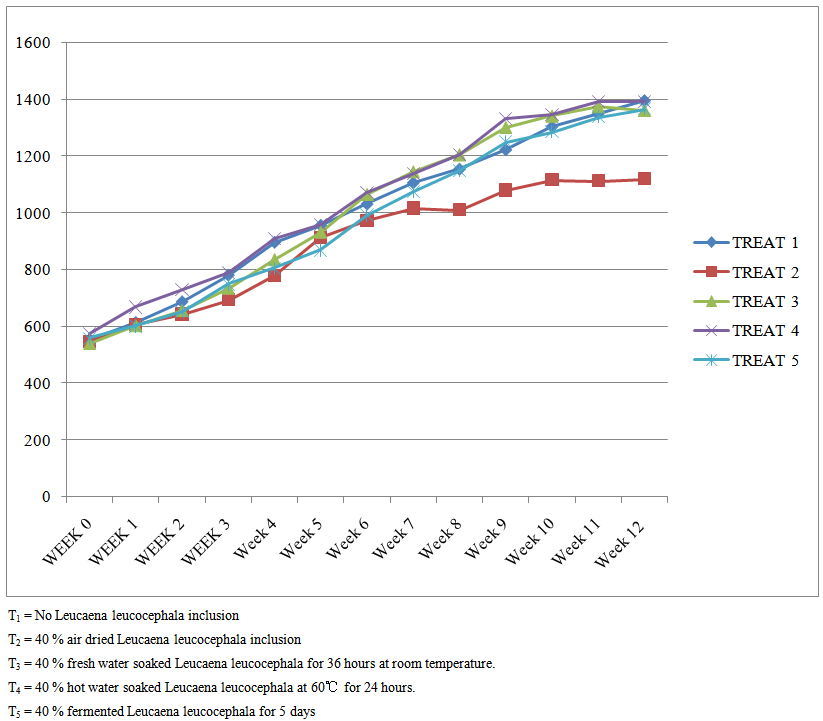 | Figure 1. Effects of dietary inclusion of differently processed Leucaena leucocephala leaf meal on growth performance of rabbits (Oryctolagus cunniculus) |
|
|
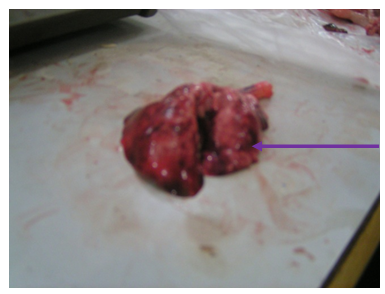 | Plate 1. Arrow showing the effect of mimosine on the lungs (multiple organ failure) of rabbit fed air dried Leucaena leucocephala leaf meal (T2) at 12 weeks |
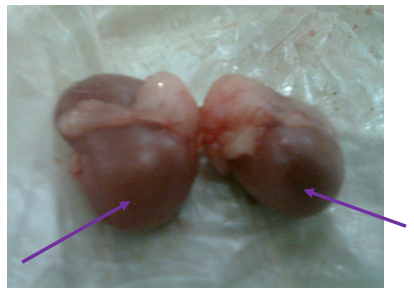 | Plate 2. Arrow showing enlarged kidneys of rabbit fed air dried Leucaena leucocephala leaf meal (T2) at 12 weeks |
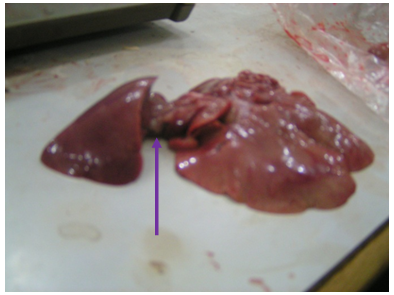 | Plate 3. Arrow showing the effects (increased liver) of Leucaena leucocephala on the liver of rabbit fed air dried Leucaena leucocephala leaf meal (T2) at 12 weeks |
|
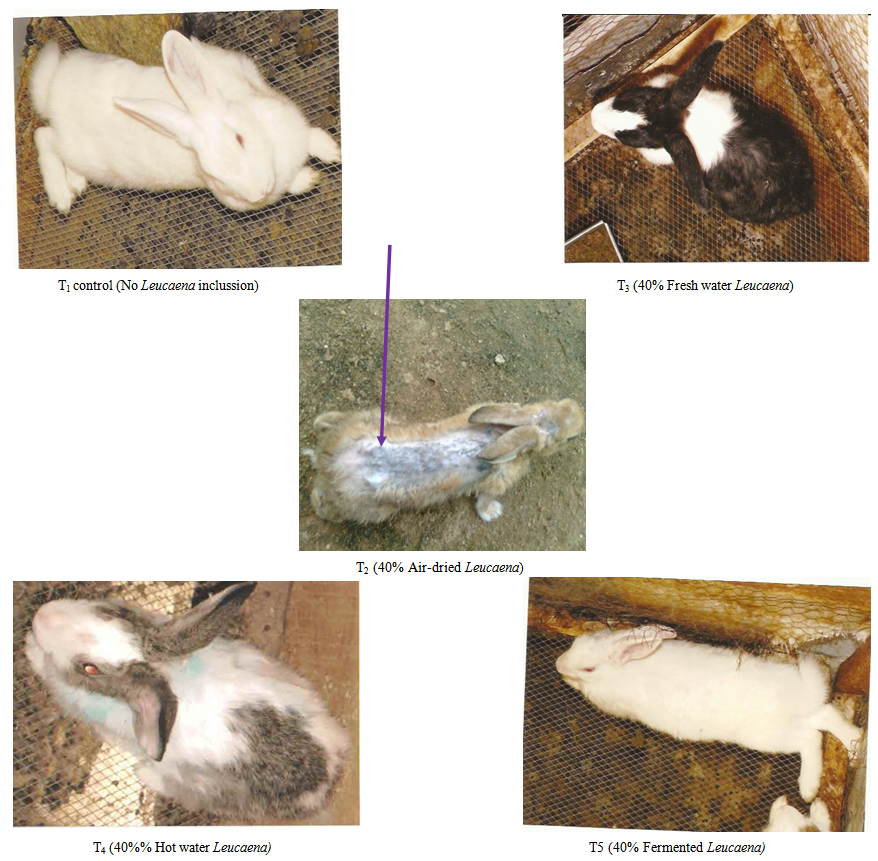 | Plate 4. (T1-T5): Arrow showing the effects (alopecia) of mimosine on rabbits fed air-dried Leucaena leucocephala leaf meal at the 12th week of the feeding trial |
4. Conclusions
- The poor performance of rabbits fed diets containing air-dried Leucaena leucocephala leaf meal in all the parameters measured were direct effects of high mimosine content in the diet due to the inability of air drying method of processing to sufficiently reduce the anti-nutritional factor to a level that will not have deleterious effect on the animals. It was therefore concluded that soaking Leucaena leucocephala leaf in fresh water for 36 hours at room temperature, in 60⁰C hot water for 24 hours and fermentation of Leucaena leucocephala leaf for 5 days are effective processing methods in reducing mimosine and other anti-nutritional factors and can be included in the diets of rabbits at 40%.
 Abstract
Abstract Reference
Reference Full-Text PDF
Full-Text PDF Full-text HTML
Full-text HTML